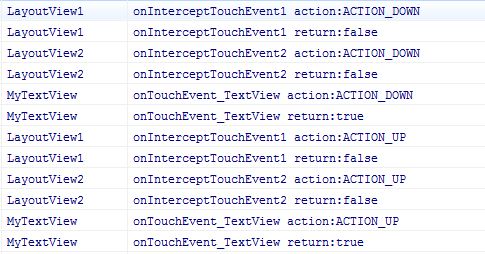onTouchEvent和onInterceptTouchEvent详细研究
面试的时候曾被问过这两个方法的调用顺序,当时也只是知道onInterceptTouchEvent在前,具体的执行过程,相互的影响却不知道.今天写了一个小demo详细研究了一下这两个方法之间的关系.
首先上代码:
主activity:InterceptTouchStudyActivity
package com.touchstudy;
import android.app.Activity;
import android.os.Bundle;
import android.widget.TextView;
public class InterceptTouchStudyActivity extends Activity {
TextView tv;
public void onCreate(Bundle savedInstanceState) {
super.onCreate(savedInstanceState);
setContentView(R.layout.main);
}
}
布局文件main.xml
<?xml version="1.0" encoding="utf-8"?>
<com.touchstudy.LayoutView1 xmlns:android="http://schemas.android.com/apk/res/android"
android:layout_width="fill_parent"
android:layout_height="fill_parent"
android:orientation="vertical" >
<com.touchstudy.LayoutView2
android:layout_width="fill_parent"
android:layout_height="fill_parent"
android:gravity="center"
android:orientation="vertical" >
<com.touchstudy.MyTextView
android:id="@+id/tv"
android:layout_width="wrap_content"
android:layout_height="wrap_content"
android:background="#FFFFFF"
android:text="AB"
android:textColor="#0000FF"
android:textSize="40sp"
android:textStyle="bold" />
</com.touchstudy.LayoutView2>
</com.touchstudy.LayoutView1>
类LayoutView1
package com.touchstudy;
import android.content.Context;
import android.util.AttributeSet;
import android.util.Log;
import android.view.MotionEvent;
import android.widget.LinearLayout;
public class LayoutView1 extends LinearLayout {
private final String TAG = "LayoutView1";
public LayoutView1(Context context, AttributeSet attrs) {
super(context, attrs);
Log.d(TAG, TAG);
}
@Override
public boolean onInterceptTouchEvent(MotionEvent ev) {
int action = ev.getAction();
switch (action) {
case MotionEvent.ACTION_DOWN:
Log.d(TAG, "onInterceptTouchEvent1 action:ACTION_DOWN");
// return true;
break;
case MotionEvent.ACTION_MOVE:
Log.d(TAG, "onInterceptTouchEvent1 action:ACTION_MOVE");
break;
case MotionEvent.ACTION_UP:
Log.d(TAG, "onInterceptTouchEvent1 action:ACTION_UP");
break;
case MotionEvent.ACTION_CANCEL:
Log.d(TAG, "onInterceptTouchEvent1 action:ACTION_CANCEL");
break;
}
boolean b = false;
Log.d(TAG, "onInterceptTouchEvent1 return:"+b);
return b;
}
@Override
public boolean onTouchEvent(MotionEvent ev) {
int action = ev.getAction();
switch (action) {
case MotionEvent.ACTION_DOWN:
Log.d(TAG, "onTouchEvent1 action:ACTION_DOWN");
break;
case MotionEvent.ACTION_MOVE:
Log.d(TAG, "onTouchEvent1 action:ACTION_MOVE");
break;
case MotionEvent.ACTION_UP:
Log.d(TAG, "onTouchEvent1 action:ACTION_UP");
break;
case MotionEvent.ACTION_CANCEL:
Log.d(TAG, "onTouchEvent1 action:ACTION_CANCEL");
break;
}
boolean b = false;
Log.d(TAG, "onTouchEvent1 return:"+b);
return b;
}
@Override
protected void onLayout(boolean changed, int l, int t, int r, int b) {
// TODO Auto-generated method stub
super.onLayout(changed, l, t, r, b);
}
@Override
protected void onMeasure(int widthMeasureSpec, int heightMeasureSpec) {
// TODO Auto-generated method stub
super.onMeasure(widthMeasureSpec, heightMeasureSpec);
}
}
类LayoutView2
package com.touchstudy;
import android.content.Context;
import android.util.AttributeSet;
import android.util.Log;
import android.view.MotionEvent;
import android.widget.LinearLayout;
public class LayoutView2 extends LinearLayout {
private final String TAG = "LayoutView2";
public LayoutView2(Context context, AttributeSet attrs) {
super(context, attrs);
Log.d(TAG, TAG);
}
@Override
public boolean onInterceptTouchEvent(MotionEvent ev) {
int action = ev.getAction();
switch (action) {
case MotionEvent.ACTION_DOWN:
Log.d(TAG, "onInterceptTouchEvent2 action:ACTION_DOWN");
break;
case MotionEvent.ACTION_MOVE:
Log.d(TAG, "onInterceptTouchEvent2 action:ACTION_MOVE");
break;
case MotionEvent.ACTION_UP:
Log.d(TAG, "onInterceptTouchEvent2 action:ACTION_UP");
break;
case MotionEvent.ACTION_CANCEL:
Log.d(TAG, "onInterceptTouchEvent2 action:ACTION_CANCEL");
break;
}
boolean b = false;
Log.d(TAG, "onInterceptTouchEvent2 return:"+b);
return b;
}
@Override
public boolean onTouchEvent(MotionEvent ev) {
int action = ev.getAction();
switch (action) {
case MotionEvent.ACTION_DOWN:
Log.d(TAG, "onTouchEvent2 action:ACTION_DOWN");
break;
case MotionEvent.ACTION_MOVE:
Log.d(TAG, "onTouchEvent2 action:ACTION_MOVE");
break;
case MotionEvent.ACTION_UP:
Log.d(TAG, "onTouchEvent2 action:ACTION_UP");
break;
case MotionEvent.ACTION_CANCEL:
Log.d(TAG, "onTouchEvent2 action:ACTION_CANCEL");
break;
}
boolean b = false;
Log.d(TAG, "onTouchEvent2 return:"+b);
return b;
}
}
面试的时候曾被问过这两个方法的调用顺序,当时也只是知道onInterceptTouchEvent在前,具体的执行过程,相互的影响却不知道.今天写了一个小demo详细研究了一下这两个方法之间的关系.
首先上代码:
主activity:InterceptTouchStudyActivity
- package com.touchstudy;
- import android.app.Activity;
- import android.os.Bundle;
- import android.widget.TextView;
- public class InterceptTouchStudyActivity extends Activity {
- TextView tv;
- public void onCreate(Bundle savedInstanceState) {
- super.onCreate(savedInstanceState);
- setContentView(R.layout.main);
- }
- }
package com.touchstudy;
import android.app.Activity;
import android.os.Bundle;
import android.widget.TextView;
public class InterceptTouchStudyActivity extends Activity {
TextView tv;
public void onCreate(Bundle savedInstanceState) {
super.onCreate(savedInstanceState);
setContentView(R.layout.main);
}
}布局文件main.xml
- <?xml version="1.0" encoding="utf-8"?>
- <com.touchstudy.LayoutView1 xmlns:android="http://schemas.android.com/apk/res/android"
- android:layout_width="fill_parent"
- android:layout_height="fill_parent"
- android:orientation="vertical" >
- <com.touchstudy.LayoutView2
- android:layout_width="fill_parent"
- android:layout_height="fill_parent"
- android:gravity="center"
- android:orientation="vertical" >
- <com.touchstudy.MyTextView
- android:id="@+id/tv"
- android:layout_width="wrap_content"
- android:layout_height="wrap_content"
- android:background="#FFFFFF"
- android:text="AB"
- android:textColor="#0000FF"
- android:textSize="40sp"
- android:textStyle="bold" />
- </com.touchstudy.LayoutView2>
- </com.touchstudy.LayoutView1>
<?xml version="1.0" encoding="utf-8"?>
<com.touchstudy.LayoutView1 xmlns:android="http://schemas.android.com/apk/res/android"
android:layout_width="fill_parent"
android:layout_height="fill_parent"
android:orientation="vertical" >
<com.touchstudy.LayoutView2
android:layout_width="fill_parent"
android:layout_height="fill_parent"
android:gravity="center"
android:orientation="vertical" >
<com.touchstudy.MyTextView
android:id="@+id/tv"
android:layout_width="wrap_content"
android:layout_height="wrap_content"
android:background="#FFFFFF"
android:text="AB"
android:textColor="#0000FF"
android:textSize="40sp"
android:textStyle="bold" />
</com.touchstudy.LayoutView2>
</com.touchstudy.LayoutView1>类LayoutView1
- package com.touchstudy;
- import android.content.Context;
- import android.util.AttributeSet;
- import android.util.Log;
- import android.view.MotionEvent;
- import android.widget.LinearLayout;
- public class LayoutView1 extends LinearLayout {
- private final String TAG = "LayoutView1";
- public LayoutView1(Context context, AttributeSet attrs) {
- super(context, attrs);
- Log.d(TAG, TAG);
- }
- @Override
- public boolean onInterceptTouchEvent(MotionEvent ev) {
- int action = ev.getAction();
- switch (action) {
- case MotionEvent.ACTION_DOWN:
- Log.d(TAG, "onInterceptTouchEvent1 action:ACTION_DOWN");
- // return true;
- break;
- case MotionEvent.ACTION_MOVE:
- Log.d(TAG, "onInterceptTouchEvent1 action:ACTION_MOVE");
- break;
- case MotionEvent.ACTION_UP:
- Log.d(TAG, "onInterceptTouchEvent1 action:ACTION_UP");
- break;
- case MotionEvent.ACTION_CANCEL:
- Log.d(TAG, "onInterceptTouchEvent1 action:ACTION_CANCEL");
- break;
- }
- boolean b = false;
- Log.d(TAG, "onInterceptTouchEvent1 return:"+b);
- return b;
- }
- @Override
- public boolean onTouchEvent(MotionEvent ev) {
- int action = ev.getAction();
- switch (action) {
- case MotionEvent.ACTION_DOWN:
- Log.d(TAG, "onTouchEvent1 action:ACTION_DOWN");
- break;
- case MotionEvent.ACTION_MOVE:
- Log.d(TAG, "onTouchEvent1 action:ACTION_MOVE");
- break;
- case MotionEvent.ACTION_UP:
- Log.d(TAG, "onTouchEvent1 action:ACTION_UP");
- break;
- case MotionEvent.ACTION_CANCEL:
- Log.d(TAG, "onTouchEvent1 action:ACTION_CANCEL");
- break;
- }
- boolean b = false;
- Log.d(TAG, "onTouchEvent1 return:"+b);
- return b;
- }
- @Override
- protected void onLayout(boolean changed, int l, int t, int r, int b) {
- // TODO Auto-generated method stub
- super.onLayout(changed, l, t, r, b);
- }
- @Override
- protected void onMeasure(int widthMeasureSpec, int heightMeasureSpec) {
- // TODO Auto-generated method stub
- super.onMeasure(widthMeasureSpec, heightMeasureSpec);
- }
- }
package com.touchstudy;
import android.content.Context;
import android.util.AttributeSet;
import android.util.Log;
import android.view.MotionEvent;
import android.widget.LinearLayout;
public class LayoutView1 extends LinearLayout {
private final String TAG = "LayoutView1";
public LayoutView1(Context context, AttributeSet attrs) {
super(context, attrs);
Log.d(TAG, TAG);
}
@Override
public boolean onInterceptTouchEvent(MotionEvent ev) {
int action = ev.getAction();
switch (action) {
case MotionEvent.ACTION_DOWN:
Log.d(TAG, "onInterceptTouchEvent1 action:ACTION_DOWN");
// return true;
break;
case MotionEvent.ACTION_MOVE:
Log.d(TAG, "onInterceptTouchEvent1 action:ACTION_MOVE");
break;
case MotionEvent.ACTION_UP:
Log.d(TAG, "onInterceptTouchEvent1 action:ACTION_UP");
break;
case MotionEvent.ACTION_CANCEL:
Log.d(TAG, "onInterceptTouchEvent1 action:ACTION_CANCEL");
break;
}
boolean b = false;
Log.d(TAG, "onInterceptTouchEvent1 return:"+b);
return b;
}
@Override
public boolean onTouchEvent(MotionEvent ev) {
int action = ev.getAction();
switch (action) {
case MotionEvent.ACTION_DOWN:
Log.d(TAG, "onTouchEvent1 action:ACTION_DOWN");
break;
case MotionEvent.ACTION_MOVE:
Log.d(TAG, "onTouchEvent1 action:ACTION_MOVE");
break;
case MotionEvent.ACTION_UP:
Log.d(TAG, "onTouchEvent1 action:ACTION_UP");
break;
case MotionEvent.ACTION_CANCEL:
Log.d(TAG, "onTouchEvent1 action:ACTION_CANCEL");
break;
}
boolean b = false;
Log.d(TAG, "onTouchEvent1 return:"+b);
return b;
}
@Override
protected void onLayout(boolean changed, int l, int t, int r, int b) {
// TODO Auto-generated method stub
super.onLayout(changed, l, t, r, b);
}
@Override
protected void onMeasure(int widthMeasureSpec, int heightMeasureSpec) {
// TODO Auto-generated method stub
super.onMeasure(widthMeasureSpec, heightMeasureSpec);
}
}
类LayoutView2


























 5万+
5万+

 被折叠的 条评论
为什么被折叠?
被折叠的 条评论
为什么被折叠?








